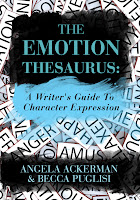Favorite Settings: A Book-Lover’s Bucket List
Today I have Becca Puglisi, co-author of The Emotion Thesaurus, telling us her favorite book settings. For me, settings can be as much a character as the people (or animals if you prefer) just like Miss Havisham's house in Great Expectations. Apparently it's the same for Becca!
When Amie asked me to share my favorite literary settings, I was
super excited. I’m a sucker for a good setting. My favorites are the ones that
feel like characters themselves, places
that elicit a strong feeling in the characters and in me. I wasn’t sure exactly
how my list of top settings would play out, but it’s not surprising that they
come from four of my favorite books.
1. Hobbiton. My first magical
landscape--even if the magic is only the
ordinary everyday sort which helps the residents disappear quietly and quickly
when large stupid folk like you and me come blundering along, making a noise
like elephants which they can hear a mile off. Hobbiton is an excellent
example of a setting as characterization. The layout of a hobbit’s hole reveals
a lot about the resident. The proliferation of pubs is telling. Even the names
of the neighboring boroughs (Bywater, Buckland, Woody End) give you an idea of
the kind of people and place you’re dealing with. The lesson I take away from
Tolkien and his settings is to choose meaningfully. Weave the story into and
through the setting instead of just dropping the character into it.
2. Prince Edward Island. The first
time I read Anne of Green Gables, I
fell in love with the sheer beauty of PEI. Every lane and field is described so
clearly. By today’s standards, the descriptions run a little long, but through
them, we see beyond a doubt L.M. Montgomery’s love for her childhood home. I’ve
always been a sucker for a place with a view, and because of this book, Prince
Edward Island is on my bucket list of places to visit.
3. Hogwarts. Come on, who doesn’t
want to go to Hogwarts? It’s got a Forbidden Forest, a sadistic poltergeist, a
lake with mermaids and a giant squid, the Shrieking Shack, and a Great Hall
that decorates itself and feeds its tenants a never ending supply and endless
variety of food. We love it because literally anything could happen there.
Naturally, not every story could withstand a Hogwarts. But every story does need
that element of surprise and uncertainty, and the setting is a great vehicle
through which we can keep the reader guessing.
4. Maycomb. This one surprised me.
The setting of To Kill a Mockingbird? Really? But I love it for its GENIUS. The
fictional town of Maycomb is symbolic of what’s happening in the story. The
heat and need for relief is tangible and quickly becomes unbearable, much like
the growing tension in the town and its desperate need for change. Small-town
summer is the perfect symbol for innocence; by the end of the story, both the
summer and the innocence are gone. It’s just such an incredible example of
thoughtful and deliberate use of a setting. Lee inspires me to think more
deeply about my settings and make them do double-duty in the story.
It was hard to whittle my list down to the top four, but these
are mine. What about you? What are your favorite settings?
 Becca
Puglisi is one half of The
Bookshelf Muse blogging duo, and co-author of The Emotion Thesaurus: A Writer's Guide to Character
Expression. Listing the body language, visceral reactions and
thoughts associated with 75 different
emotions, this brainstorming guide is a valuable tool for showing, not telling,
emotion. The
Emotion Thesaurus is available for purchase through Amazon, Barnes & Noble, iTunes, and Smashwords,
and the PDF can be purchased directly from her blog.
Becca
Puglisi is one half of The
Bookshelf Muse blogging duo, and co-author of The Emotion Thesaurus: A Writer's Guide to Character
Expression. Listing the body language, visceral reactions and
thoughts associated with 75 different
emotions, this brainstorming guide is a valuable tool for showing, not telling,
emotion. The
Emotion Thesaurus is available for purchase through Amazon, Barnes & Noble, iTunes, and Smashwords,
and the PDF can be purchased directly from her blog.